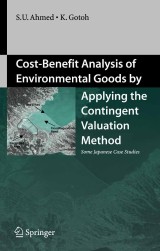Details

Cost-Benefit Analysis of Environmental Goods by Applying Contingent Valuation Method
Some Japanese Case Studies|
96,29 € |
|
| Verlag: | Springer |
| Format: | |
| Veröffentl.: | 14.12.2007 |
| ISBN/EAN: | 9784431289500 |
| Sprache: | englisch |
| Anzahl Seiten: | 160 |
Dieses eBook enthält ein Wasserzeichen.
Beschreibungen
<P>Contingent valuation is one of the means of incorporating socio-environmental considerations in cost–benefit analysis. The authors of this book have examined environmental valuation methods through the lens of cost–benefit analysis focused on three case studies in Japan: public parks, a bay wetland, and a recreational theme park. With implications for the world at large, the findings presented here serve as a valuable source of information on Japanese behavior regarding the valuation of environmental goods. New, alternative approaches and guidelines for cost–benefit analysis in the public and private spheres also are discussed. This volume makes an important addition to the library of all researchers and other scientists in the fields of environmental science and environmental economics.</P>
Overview.- Contingent Valuation Method.- Case Study 1: The Isahaya Bay Wetland (IBW).- Overview of the IBW.- Environmental Valuation of the IBW.- Recalculating Cost-Benefit Analysis of the IBRP.- Case Study 2: Public Parks.- Estimation of the WTP for Preserving Public Parks.- Case Study 3: The Huis Ten Bosch.- Overview of the HTB.- Environmental Valuation of the HTB.- Calculating Cost-Benefit Analysis of the HTB.- New Approaches for Environmental Valuation.- Effect of Distance on Willingness to Pay.- Free Comments in CV Survey and Their Impact on WTP.- Integration of CVM and Remote Sensing Technique for Environmental Valuation.- Effect of Question Format on WTP in CV Studies.- Summary and Conclusion.- Policy Recommendations and Conclusion.
The basic approach of cost-benefit analysis (CBA) followed in Japan for both public and private projects The way to incorporate socio-environmental factors, e.g., public opinion regarding a development project in the CBA Using remote sensing technique can check CBA conducted by following economic technique such as contingent valuation method The most important factors influencing the environmental valuation and CBA in Japan Finally, incorporating opinion of various interest groups (stakeholders) can ensure the sustainability of a development project and reduce public debate afterwards

















